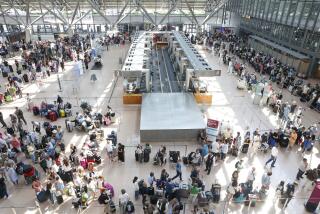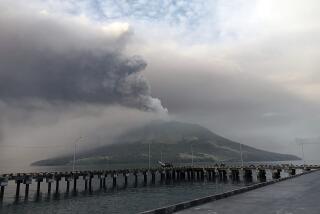Volcanic ash an ill wind for airlines and tourism
- Share via
A volcanic plume from Iceland that has shut down airports and disrupted air travel across Northern Europe and Scandinavia is casting a dark shadow over the recovery of the struggling international travel and tourism industries.
Authorities had shut down some airports and canceled hundreds of flights Friday from dozens of other European airports, including the world’s three busiest international airports: London’s Heathrow, Paris’ Charles De Gaulle and Amsterdam’s Schiphol. Combined, the three airports handle more than 164 million passengers a year.
The airport closures and flight cancellations could cost the airline industry more than $200 million a day in revenue, according to the International Air Transport Assn., the trade group that represents most major airlines.
The disruption of flights is also expected to cut into tourist spending in Europe, the U.S. and elsewhere.
“The bottom line is when you start closing or restricting European gateways, it has a ripple effect across the world,” said Steve Lott, a spokesman for the IATA.
On Friday, only about 12,000 flights came in and out of Europe, compared with a normal daily total of 28,000, according to Eurocontrol, a Europe-wide aviation agency. On a typical day, about 600 flights cross the Atlantic between North America and Europe. But the volcanic plume limited those flights to about 120 arrivals Friday morning.
“There is still very extensive coverage of northwestern Europe by the volcanic ash cloud,” said Brian Flynn of Eurocontrol. He said the cloud seemed to be moving south and east.
The disruption will hit some airlines harder than others.
British Airways, the world’s fifth-largest international carrier, with hubs at London’s Heathrow and Gatwick airports, was in effect shut down. Meanwhile, American Airlines, the third-largest U.S. carrier, canceled only 35 of its 3,400 daily flights Friday.
The disruption came just as airlines were beginning to see international passenger numbers start to rebound from a steep decline that began in late 2008.
In February, the number of international passengers increased by nearly 7% compared with the same month in 2009. Despite the improving numbers, the industry has yet to see the volume of air traffic return to pre-recession numbers.
But airline officials could only guess at the final cost of the volcanic cloud because it remained uncertain how long the plume would linger.
“It’s much too early to try to figure out the impact,” British Airways spokesman John Lampl said.
In addition to losing revenue from grounded flights, the airline is paying for hotel bills of stranded passengers. In Los Angeles alone, he estimated, the airline picked up the hotel tab Thursday for more than 2,000 of its passengers.
“It’s a significant impact, but we have to do that for our customers,” he said.
Among those stranded fliers was Graham Johnston, one of 21 British travel agents who were in Los Angeles this week to learn about Southern California’s attractions.
Johnston and the other agents had been set to return to London on Thursday but had to bide their time at a hotel near Los Angeles International Airport. He said he and his colleagues shared dinner, drinks and bowling.
“We met lots of locals and had a good time,” he said.
The flight cancellations are particularly painful to Los Angeles, where tourism is the region’s second-largest industry. Direct spending by foreign visitors generated $4.6 billion in 2008. Each year, about 725,000 visitors from Britain, France and Germany visit the area.
Mark Liberman, president of LA Inc., the Los Angeles convention and visitors bureau, said foreign tourists usually stay longer and spend more money than do domestic visitors.
Although the volcanic cloud may be keeping some new tourists from flying into Los Angeles, the visitors who are stranded in the city can at least enjoy good weather and plenty of activities, Liberman said.
“If I had to be stuck anywhere, I would want to be stuck in Los Angeles,” he said.
More to Read
Sign up for Essential California
The most important California stories and recommendations in your inbox every morning.
You may occasionally receive promotional content from the Los Angeles Times.










